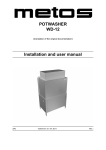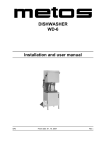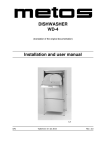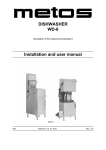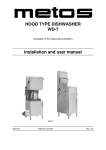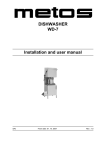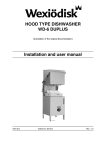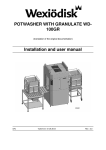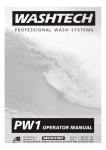Download POTWASHER WD-12 Installation and user manual
Transcript
POTWASHER WD-12 (translation of the original documentation) Installation and user manual S/N: Valid from: 01. 04. 2011 Rev.: WD-12 Rev. 1. General information ......................................................................... 1 1.1 Symbols used in this manual ........................................................................... 1.2 Symbols on the dishwasher ............................................................................. 1.2.1 Machine marking ...................................................................................... 1.3 Checking that the machine and the manual correspond .................................. 1 2 2 2 2. Safety instructions ........................................................................... 3 2.1 General information ......................................................................................... 2.2 Transport .......................................................................................................... 2.3 Installation ........................................................................................................ 2.4 Detergent and drying agent ............................................................................. 2.5 Operation ......................................................................................................... 3 3 3 4 4 2.5.1 Hot water .................................................................................................. 2.5.2 Crushing risk ............................................................................................. 2.6 Cleaning the dishwasher .................................................................................. 2.6.1 Pressure washing ..................................................................................... 2.7 Washing the floor ............................................................................................. 2.8 Repairing and servicing the dishwasher .......................................................... 4 4 4 4 4 5 2.9 Recycling the machine ..................................................................................... 5 3. Installation ........................................................................................ 6 3.1 General information ......................................................................................... 6 3.2 Requirements for the installation site ............................................................... 6 3.2.1 Lighting ..................................................................................................... 6 3.2.2 Ventilation ................................................................................................. 6 3.2.3 Drain ......................................................................................................... 6 3.2.4 Space for servicing ................................................................................... 6 3.3 Transport and storage ...................................................................................... 7 3.3.1 Unpacking ................................................................................................. 7 3.3.2 Recycling the packaging ........................................................................... 7 3.4 Installation ........................................................................................................ 8 3.4.1 Positioning the machine ............................................................................ 8 3.4.2 Installing auxiliary equipment .................................................................... 8 3.5 Connections ..................................................................................................... 9 3.5.1 Electrical connection ............................................................................... 10 3.5.2 Water connection .................................................................................... 10 3.5.3 Drain connection ..................................................................................... 10 3.5.4 Bleeding the hood lift .............................................................................. 11 3.5.5 Detergent and drying agent connection .................................................. 11 WD-12 Rev. 3.6 Settings options for detergent and drying agent equipment (option) ................................................................................................................. 11 3.6.1 24V AC or 230V AC power supply for detergent and drying agent dosing via relay 9/J71 and relay 11/J73 ..................................................................... 12 3.6.2 Settings options for relay 9/J71 .............................................................. 14 3.6.3 Settings options for relay 11/J73 ............................................................ 15 3.7 Trial operation ................................................................................................ 16 3.7.1 Start-up schedule .................................................................................... 16 3.8 Technical documentation ............................................................................... 18 4. Instructions for use ........................................................................ 19 4.1 Preparations ................................................................................................... 4.1.1 The machine's design ............................................................................. 4.1.2 Preparations before filling ....................................................................... 4.1.3 Filling the machine .................................................................................. 4.2 Using the machine ......................................................................................... 4.2.1 Programme selection – Normal load (-)/Heavily soiled load (+) ............. 4.2.2 Changing the washing temperature and washing time ........................... 4.2.3 Washing .................................................................................................. 4.2.4 Changing the water ................................................................................. 4.3 After use – cleaning ....................................................................................... 4.3.1 Draining and internal cleaning (machine without drain pump) ................ 4.3.2 Draining and internal cleaning (machine with drain pump) (option) ........ 4.3.3 Cleaning each week ............................................................................... 4.3.4 Cleaning the exterior ............................................................................... 4.3.5 Incorrect cleaning methods ..................................................................... 4.3.6 Operating problems ................................................................................ 19 19 21 21 22 22 23 25 26 27 28 29 30 30 31 32 5. Technical information .................................................................... 35 WD-12 Rev. (201104) General information 1. General information Read the instructions in this manual carefully as they contain important information regarding the correct, effective and safe installation, use and servicing of the dishwasher. Keep this manual in a safe place so that it can be used by other operators of the dishwasher. The electronics in the machine are RoHS compatible. 1.1 Symbols used in this manual This symbol warns of situations where a safety risk may arise. The instructions given should be followed in order to prevent injury. This symbol on a machine component warns of the presence of electrical equipment. The machine is sensitive to electrostatic discharge (ESD), which is why a static electricity wristband must be used when handling the electronics. This symbol explains the correct way to perform a task in order to prevent poor results, damage to the dishwasher or hazardous situations. This symbol identifies recommendations and hints to help you to get the best performance from the machine. This symbol explains the importance of careful and regular cleaning of the machine to meet hygiene requirements. 1 WD-12 Rev. (201104) General information 1.2 Symbols on the dishwasher This symbol on a component is a warning of electrical equipment. The component may only be removed by a qualified electrician. The machine is sensitive to electrostatic discharge (ESD), which is why a static electricity wristband must be used when handling the electronics. 1.2.1 Machine marking The machine has two rating plates, one of which is placed at the bottom of one side of the machine and the other in the electrical cabinet. The technical information on the plates is also included on the machine's wiring diagram. The various rating fields show: Wexiödisk AB Type No 1 5 V M 3 2 6 9 kW IP 4 7 Hz 8 10 kW A 11 kW Mårdvägen 4, S-352 45 V ÄXJÖ SWEDEN 1. 2. 3. 4. 5. 6. 7. 8. 9. 10. 11. 1.3 marks_07 Machine type Machine serial number Year of manufacture Enclosure protection class Voltage Number of phases with or without zero Frequency Main fuse Motor output Electrical heating output Max. output Checking that the machine and the manual correspond Check that the type description on the rating plate corresponds with the type description on the front of the manual. If manuals are missing, it is possible to order new ones from the manufacturer or the local distributor. When ordering new manuals, it is important to quote the machine serial number found on the rating plates. 2 WD-12 Rev. (201104) Safety instructions 2. Safety instructions 2.1 General information The machine is CE marked, which means that it complies with the requirements of the EU machinery directive with regard to product safety. Product safety means that the design of the machine will prevent personal injury or damage to property. Modifying the equipment without the approval of the manufacturer invalidates the manufacturer’s product liability. To further improve safety during installation, operation and servicing, the operator and the personnel responsible for installing and servicing the machine should read the safety instructions carefully. Switch off the machine immediately in the event of a fault or malfunction. The machine must only be serviced by trained engineers. The regular checks described in the manual must be carried out in accordance with the instructions. The machine must be serviced by a person authorised to do so by the manufacturer. Use original spare parts. Contact an authorised service company to draw up a programme of preventative maintenance. Dangerous situations may arise if the instructions above are not followed. Before using the machine, ensure that personnel are given the necessary training in operating and maintaining the machine. 2.2 Transport Handle the machine with care during unloading and transport to avoid the risk of it tipping over. Never lift or move the machine without using the wooden packaging to support the stand. 2.3 Installation The electrical cabinet must only be opened by an authorised electrician. The machine is sensitive to electrostatic discharge (ESD), which is why a static electricity wristband must be used when handling the electronics. Water and steam pipes must only be connected by authorised personnel. Water pipes must be connected in a way that complies with the current regulations of the local water supply authority. Check that the water connections do not leak before starting the machine. Make sure that the mains voltage is the same as that indicated on the machine's rating plate. The machine should be connected to a lockable mains switch. 3 WD-12 Rev. (201104) Safety instructions 2.4 Detergent and drying agent Only detergent and drying agent intended for industrial dishwashing machines must be used. Ordinary washing-up liquid must not be used in the machine or for soaking. Contact your detergent supplier regarding the choice of a suitable detergent. Be aware of the risk of handling washing and drying agents. Protective gloves and safety glasses should be used when handling dishwasher detergent. Read the warning text on the detergent and drying agent containers as well as the detergent supplier's regulations. 2.5 Operation 2.5.1 Hot water The temperature of the washing water is 60°C and that of the rinsing water 85°C. Do not open the hood until the rinsing phase has finished. 2.5.2 Crushing risk When using a dishwasher with automatic hood lift, be very careful when raising and lowering the hood. 2.6 Cleaning the dishwasher The water in the tank has a temperature of approximately 60°C and contains detergent. Take care when draining and cleaning the dishwasher. Use protective gloves. 2.6.1 Pressure washing The machine must not be cleaned with a pressure washer, either inside or out. In order to satisfy current requirements, electrical components of approved IP classes are used. No enclosure classes are designed to withstand pressurised water. 2.7 Washing the floor When the floor is washed, water can splash up under the machine and damage the components. These have not been designed to withstand being washed with water. Do not wash the floor within 1 metre of the dishwasher. Pressure washers have special protective cases which can be fitted to prevent water splashing. Problems with splashing can also occur when using ordinary hoses. 4 WD-12 Rev. (201104) Safety instructions 2.8 Repairing and servicing the dishwasher Disconnect the power supply before removing the front panel. Avoid touching hot pipes and the booster heater. Check the following: • • • • Has the machine been used according to the instructions? Are all the removable parts in the correct place? Is the mains switch in the ON position? Are the fuses in the electrical cabinet undamaged? Ask the service personnel to check the fuses. If this does not solve the problem, ask authorised service personnel to check the machine. 2.9 Recycling the machine When the dishwasher has reached the end of its service life, it must be recycled in accordance with current regulations. Contact a company which specialises in recycling. 5 WD-12 Rev. (201104) Installation 3. Installation 3.1 General information The machine must be installed by authorised personnel only. Read these instructions carefully, as they contain important information regarding the correct installation method. The instructions should be used together with the machine's wiring diagram and flow diagram. The machine is CE marked. The CE mark is only valid for machines that have not been modified. If the machine is damaged as a result of the instructions not being followed, this invalidates the supplier's guarantee and the product liability. 3.2 Requirements for the installation site 3.2.1 Lighting In order to ensure the best possible working conditions during installation, operation, servicing and maintenance, make sure that the machine is installed in a welllit room. 3.2.2 Ventilation The machine produces heat and steam when in operation. In order to ensure the best possible working conditions, a certain air change rate is required in the dishwashing room. The ventilation requirements for the room are dimensioned as per applicable standards. 3.2.3 Drain There must be a floor drain for the machine's waste water. The floor drain capacity can be found in the TECHNICAL SPECIFICATIONS. 3.2.4 Space for servicing A 1-metre area should be left clear in front of the machine for servicing purposes. 6 WD-12 Rev. (201104) Installation 3.3 Transport and storage Always transport the machine in an upright position. Take care during transport, as there is a risk of the equipment tipping over. NOTE: The machine must not be transported without a pallet or other support, otherwise the machine may become damaged. When transporting the machine without a normal wooden pallet, always check that none of the components underneath the machine can be damaged. A WD4_17 A=Wooden pallet If the machine is not being installed immediately, it must be stored in a frost-free area where the air is dry. 3.3.1 Unpacking Remove the packing material. Inspect the machine for any transport damage. Check that all parts have been delivered by comparing them with the delivery note. 3.3.2 Recycling the packaging Packaging must be disposed of or recycled in accordance with local regulations. 7 WD-12 Rev. (201104) Installation 3.4 Installation Check that the overheating protection on the booster heater and the tank element are set to zero. 3.4.1 Positioning the machine Put the machine in position and check that it is horizontal using a spirit level. Adjust the height using the machine's legs. 3.4.2 Installing auxiliary equipment Once the machine is in place and has been adjusted horizontally and vertically, the auxiliary equipment can be fitted. 50 NOTE: When connecting sinks and conveyors, no holes must be drilled in the machine. A 50 B B B 20 20 3 A A 50 6 304222 A=Connection sink B=Connection conveyor 8 6 WD-12 Rev. (201104) Installation 3.5 Connections 1. 2. 3. 4. 5. 6. 7. 8. Electrical connection Hot water connection Drain connection Plugged hole for detergent hose Bleeding screw, hood lift Steam connection (steam-heated machine) (option) Condensation water connection (steam-heated machine) (option) Alternative electrical connection 9 WD-12 Rev. (201104) Installation 3.5.1 Electrical connection This symbol on a component is a warning of electrical equipment. The component may only be removed by a qualified electrician. The machine is sensitive to electrostatic discharge (ESD), which is why a static electricity wristband must be used when handling the electronics. Information on electrical connection is shown on the machine's wiring diagram. These diagrams are located in the plastic file on the inside of the front panel. Store them in the file provided after installation too. The machine must be connected to a lockable mains switch. This should be placed on a wall, well-protected from water and from the steam which escapes when the hood is opened. The machine is supplied with the electricalcable connected (1). 3.5.2 Water connection Ensure that the machine is evenly balanced. Adjust the machine using the legs. A shut-off cock and non-return valve must be installed on the supply pipes. The water supply pipe is fitted with a break tank. Connect the water pipe according to the marks by the connection point (2). For a steam-heated dishwasher, connect the pipes for the steam (6) and condensation water (7) as well. If the machine is connected to a hose, the internal diameter of the hose must be at least 12 mm. The required water flow and pressure can be found in the TECHNICAL SPECIFICATIONS section. 3.5.3 Drain connection Machines without a drain pump The waste water system connected to (3) should consist of a 50 mm metal pipe that will withstand mechanical impacts. The drain must run to a floor drain, where its opening must be above the water level. The capacity of the floor drain must be 3 litres/second. Machines with a drain pump (option) The pipe from the drain pump must run to a sink and the opening must be a minimum of 25 mm above the sink. 10 WD-12 Rev. (201104) Installation 3.5.4 Bleeding the hood lift • • • • Open the bleed screw (5). Press the 0/1 button. Open the hood. Close the bleed screw (5) when water comes out of the hole on the screw. 3.5.5 Detergent and drying agent connection Drying agent equipment is included with the machine. Connect the suction hose on the drying agent injector to the drying agent container. If equipment for a different type of detergent is used, it should preferably be put on the wall behind the machine to avoid holes being drilled unnecessarily in the machine. The setting of the detergent and drying agent dosage is described in ADJUSTMENT INSTRUCTIONS. Electrical connections, see wiring diagram. The machine can also be equipped with detergent and drying agent equipment via "external" connections. See the wiring diagram for the correct connection. 3.6 Settings options for detergent and drying agent equipment (option) Check which equipment is fitted to the machine before starting work. Switch off the power supply to the machine at the mains switch before starting work in the electrical cabinet. The first "24V AC or 230V AC power supply for detergent and drying agent dosing via relay 9/J71 and relay 11/J73" explains how the contacts are supplied with the relevant voltage. The second section "Settings options for relay 9/J71 and relay 11/J73" describes the different settings available and how they can be changed. 11 WD-12 Rev. (201104) Installation 3.6.1 24V AC or 230V AC power supply for detergent and drying agent dosing via relay 9/J71 and relay 11/J73 The detergent and drying agent dosage system can take its power from two relays on the data card. The relays can be dead, with no power supply, (trigger function) or they can be connected to a 24V AC or 230V AC supply to power the dosage system. Each relay has a contact for connecting the equipment. Relay 9 for detergent is connected via a 3-pin J71 contact. Relay 11 for drying agent is connected via a 2-pin J73 contact. For correct connection at X10, see the machine's wiring diagram. 230V AC equipment should not draw more than 1.5A. 24V AC equipment should not draw more than 1.5A. The time and method for switching on the relays is determined by the settings in the table of reference values. See the section "Settings options for relay 9/J71 and relay 11/J73". Relay 9/J71. Dead closing function (trigger function) 230V/400V machine) To use the closing function without a power supply, follow these instructions: • Contact the equipment to be controlled to contacts J71-101 and J71-105. Relay 9/J71. 230V AC version (400V 3-phase machine) To connect a 230V AC power supply to the contact, follow these instructions: • • • Connect a blue 0.75mm² wire from connector N in the electrical cabinet to contact J71-102. Connect a black 0.75mm² wire from connector X10 to contact J71-105. Connect the equipment to be controlled to contacts J71-101 and J71-102. There will be two wires connected to contact J71-102. Relay 9/J71. 230V AC version (230V 3-phase machine) To connect a 230V AC power supply to the contact, follow these instructions: • • • Connect a black 0.75mm² wire from connector X10 in the electrical cabinet to contact J71-102. Connect a black 0.75mm² wire from mini-switch FU/M-2 to contact J71105. Connect the equipment to be controlled to contacts J71-101 and J71-102. There will be two wires connected to contact J71-102. 12 WD-12 Rev. (201104) Installation Relay 9/J71. Relay 9. 24V AC version (230V/400V 3-phase machine) To connect a 24V AC power supply to the contact, follow these instructions: • • • Connect a red 0.75mm² wire from connector 0V in the electrical cabinet to contact J71-102. Connect a red 0.75mm² wire from the 8-pin contact on the data card labelled J69-8 (24V) to contact J71-105. Connect the equipment to be controlled to contacts J71-101 and J71-102. There will be two wires connected to contact J71-102. Relay 11/J73. Dead closing function (trigger function) (230V/400V 3-phase machine) To use the closing function without a power supply, follow these instructions: • Contact the equipment to be controlled to contacts J73-103 and J73-104. Relay 11/J73. 230V AC version (400V 3-phase machine) To connect a 230V AC power supply to the contact, follow these instructions: • • • If a 230V AC version of J71 is fitted: Connect J71-105 to J73-104 using a black 0.75mm² wire. If J71 is not fitted or is not a 230V AC version: Connect a black 0.75mm² wire from connector X10 to contact J73-104. Connect the equipment to be controlled between contact J73-103 and connector N in the electrical cabinet. Relay 11/J73. 230V AC version (230V 3-phase machine) To connect a 230V AC power supply to the contact, follow these instructions: • • • If a 230V AC version of J71 is fitted: Connect J71-105 to J73-104 using a black 0.75mm² wire. If J71 is not fitted or is not a 230V AC version: Connect a black 0.75mm² wire from mini-switch FU/M-2 to contact J73-104. Connect the equipment to be controlled between contact J73-103 and connector X10 in the electrical cabinet. Relay 11/J73. Relay 11. 24V AC version (230V/400V 3-phase machine) To connect a 24V AC power supply to the contact, follow these instructions: • • • If a 24V AC version of J71 is fitted: Connect J71-105 to J73-104 using a red 0.75mm² wire. If J71 is not fitted or is not a 24V AC version: Connect a red 0.75mm² wire from the 8-pin contact on the data card labelled J69-8 (24V) to contact J73104. Connect the equipment to be controlled between contact J73-103 and connector 0V in the electrical cabinet. 13 WD-12 Rev. (201104) Installation 3.6.2 Settings options for relay 9/J71 The function of relay 9/J71 can only be influenced by the reference value on row 22. Relay 9/J71. Set/change the dosage interval during filling and final rinse. 1. 2. 3. 4. 5. 6. 7. 8. Switch on the power to the machine. Go into S1 mode, by pressing the service button on the data card. Go to row 22. Increase the setting by pressing "P2". Reduce the setting by pressing "P3". Leave S1 mode by pressing the 0/1 button. The setting is saved when you leave S1 mode. The new value will be used next time the machine is filled or after the next final rinse, when the chemical wash starts. Relay 9/J71. Constant voltage when the machine is started 1. 2. 3. 4. 5. 6. 7. Switch on the power to the machine. Go into S1 mode, by pressing the service button on the data card. Go to row 22. Change the setting to "00". Leave S1 mode by pressing the 0/1 button. The setting is saved when you leave S1 mode. The new value will be used as soon as it is applicable. Relay 9/J71. Parallel operation with the chemical pump 1. 2. 3. 4. 5. 6. 7. Switch on the power to the machine. Go into S1 mode, by pressing the service button on the data card. Go to row 22. Change the setting to "99". Leave S1 mode by pressing the 0/1 button. The setting is saved when you leave S1 mode. The new value will be used as soon as it is applicable. 14 WD-12 Rev. (201104) Installation 3.6.3 Settings options for relay 11/J73 Set the correct function for relay 11/J73 by ensuring that the reference value on row 105 is set to "0", which corresponds to "external dosing of drying agent", before starting on the settings on row 23. Relay 11/J73. Set/change the dosage interval during filling and final rinse. 1. 2. 3. 4. 5. 6. 7. 8. Switch on the power to the machine. Go into S1 mode, by pressing the service button on the data card. Go to row 23. Increase the setting by pressing "P2". Reduce the setting by pressing "P3". Leave S1 mode by pressing the 0/1 button. The setting is saved when you leave S1 mode. The new value will be used during the next final rinse. Relay 11/J73. Parallel operation with final rinse valve (hose pump) 1. 2. 3. 4. 5. 6. 7. Switch on the power to the machine. Go into S1 mode, by pressing the service button on the data card. Go to row 23. Change the setting to "00". Leave S1 mode by pressing the 0/1 button. The setting is saved when you leave S1 mode. The new value will be used as soon as it is applicable. Relay 11/J73. Parallel operation with the chemical pump 1. 2. 3. 4. 5. 6. 7. Switch on the power to the machine. Go into S1 mode, by pressing the service button on the data card. Go to row 23. Change the setting to "99". Leave S1 mode by pressing the 0/1 button. The setting is saved when you leave S1 mode. The new value will be used as soon as it is applicable. 15 WD-12 Rev. (201104) Installation 3.7 Trial operation Prepare the machine for trial operation by following the INSTRUCTIONS FOR USE. The instructions describe the measures that must be taken to prepare the machine for operation. 3.7.1 Start-up schedule This should be completed and signed by the customer on start-up. Machine type: Machine serial number: Installation date: Customer: Postal address: Telephone: Contact: Dealer: Telephone: Contact: Installation company: Telephone: Contact: Service company: Telephone: Detergent supplier: Telephone: End-user signature: Name (in capitals): Read the installation and user manuals carefully. Then check the following points: 16 WD-12 Rev. (201104) Installation 1. Check: • • • • • Water and drain connections That the machine is evenly balanced Detergent and drying agent Filters and level pipe are in place The overheating protection for the booster heater and the tank element are set to zero. 2. Filling the machine: • • • Turn on the mains switch and any circuit breakers Close the hood Fill the machine with water as per the INSTRUCTIONS FOR USE 3. Start the machine: • Check the pump's direction of rotation NOTE: If the pump is rotating in the wrong direction, the phase must be inverted on the terminal block for the incoming electrical connection. 4. Check the setting of the reference values: • • (All the reference values have been set to the recommended values on delivery.) The delay for the booster pump 5. Run a number of washes complete with loads and check that: • • • • • There are no water leaks The automatic hood lift's anti-crushing system is working The water temperatures are maintained The washed items are clean The washed items are dried Note: The drying agent equipment is roughly set at the factory; contact your detergent supplier for a more precise setting. 6. Final check: Empty the machine and turn off the power using the mains switch. • • • Re-tighten all connections on relays and any circuit breakers Set all the circuit breakers to the on position Display the maintenance instructions supplied with the machine 7. Train the dishwashing staff 17 WD-12 Rev. (201104) Installation 3.8 Technical documentation To ensure that the machine is operated and serviced correctly, it is important that the documentation supplied with the machine is made available to the personnel using it. The installation and user manual, which describes, amongst other things, how to operate and maintain the machine, should be stored near the machine. If the service manual is supplied with the machine, it should be given to the service engineer who is responsible for the machine. If the spare parts manual is supplied with the machine, it should be given to the service engineer who is responsible for the machine. 18 WD-12 Rev. (201104) Instructions for use 4. Instructions for use All personnel using the machine must be given training in how the machine works by the person responsible for staff safety. The dishwasher should not be used by anyone suffering from a physical or mental illness. Children should be watched closely to ensure that they do not play with the machine. 4.1 Preparations 4.1.1 The machine's design 1 C 2 3 4 10 17 11 5 P1 6 7 P2 8 P3 9 16 15 18 12 13 14 12_100 19 WD-12 Rev. (201104) Instructions for use 1. 2. 3. 4. 5. 6. 7. 8. 9. 10. 11. 12. 13. 14. 15. 16. 17. 18. Symbol for washing function. After the machine is started, the symbol lights up when the tank is full. The symbol flashes if the water level in the tank is too low. Display for temperature during operation. When checking and setting reference values, the display shows the number for the relevant reference value, e.g. 01, 02, 03, etc. Error messages are shown together with the display (4). Final rinse indicator. The symbol is lit while the machine is filling up, during the final rinse phase and when the cleaning programme is run after a completed washing cycle. The symbol flashes if the door is opened during the washing cycle or if the correct rinse temperature has not been reached when the rinsing is due to start. Display for program display during operation. When checking and setting the reference values, the display shows the relevant reference value. Button for opening/closing the hood. Button for washing program P1. When the machine is in service mode, P1 is used to show the different reference values and to reset the reference values to the last saved values. If the machine has a drain pump, P1 is used to start the drain pump and empty the tank after washing. Button for washing program P2. P2 is used in service mode to increase a reference value or jump between tables. In shut-off mode the software version number can be displayed by holding down P2. Button for washing program P3. P3 is used in service mode to reduce a reference value or jump between tables. P3 is used in shut-off mode to start internal rinsing when the cleaning programme is used to clean the machine. Button to switch the power on or off. This button is also used to reset alarms, display the water flow to the machine and to move to service mode. Washing arm (qty. 4), removable Hinged grid shelf (option) Level pipe Rubber sleeve Pump filter (qty. 2) Levers (qty. 2) for selecting Normal load (-) and Heavily soiled load (+) Basket conveyor Washing pipe Strainer (qty. 4) 20 WD-12 Rev. (201104) Instructions for use 4.1.2 Preparations before filling Numbers in brackets refer to the diagram in the chapter "The machine's design". Check: • • • • that the dishwasher and all removable components are clean and that there is no dirt in the nozzles of the washing arms and rinsing pipes (10, 17). that the level pipe seal (13) is undamaged. that the shut-off cock for the water is open. the amount of detergent and drying agent. Washing up liquid must not be used in the machine or for soaking dishes. It causes foam to form and produces poor washing results. Fit: The level pipe (12), pump filters (14), strainers (18). The rubber seal of the level pipe (13) must be sealed against the bottom plate. Depending on the items to be washed, the grid shelf (11) (option) may need to be folded down when washing heavily soiled loads. 4.1.3 Filling the machine Numbers in brackets refer to the diagram in the chapter "The machine's design". • • • Switch on the power using the 0/1 button (9). Close the hood by pressing button (5). The display (2) shows the temperature of the rinsing water. The display (4) shows P0. P0 is a pause mode which indicates that no washing programme has been selected. The filling commences when the temperature is 85°. When the machine has filled up, the symbol (1) lights up and the washing temperature is shown in the display (2). If the washing temperature falls below the set value by more than 5°C, the temperature shown on the display (2) flashes. The machine cannot start washing until the set temperature minus 5°C for the washing water has been reached, if this function is selected. The normal operating temperature for the washing phase is 60°C. The heating time is dependent on the incoming water temperature. If the washing temperature falls below 50°C, the temperature display flashes. 21 WD-12 Rev. (201104) Instructions for use 4.2 Using the machine C 1 2 3 4 10 17 11 5 P1 6 7 P2 8 P3 9 16 15 18 12 13 14 12_100 4.2.1 Programme selection – Normal load (-)/Heavily soiled load (+) The machine can be used as a standard dishwasher for washing plates and glassware or as a potwasher. If using the machine for a normal load (-), the levers (15) must be at the (-) position. The different programs are then used as follows: The control panel has three programme buttons: P1, P2 and P3. • • • P1=Lightly soiled items (e.g. trays and glassware) P2=Normal load P3=Heavily soiled items For heavily soiled loads, move the levers (15) to the (+) position. Depending on the items to be washed, the grid shelf (11) (option) may need to be folded down when washing heavily soiled loads. The washing temperature and chemical washing time for each programme is set on delivery. The operator can change these values if required. 22 WD-12 Rev. (201104) Instructions for use 4.2.2 Changing the washing temperature and washing time The factory setting for the washing temperature is 60°C. The operator can adjust the temperature to between 55 and 70°C. The chemical washing times for each programme are set on delivery to: • • • 1,0 min. (programme P1) 3,0 min. (programme P2) 5,0 min. (programme P3) The washing times can be adjusted between 1.0 and 6.0 minutes. Changing the values – Selecting service mode The machine must be set to service mode when the operator needs to change a value. This is done using the control panel. The values that can be changed flash. The displays and buttons have different functions than when the machine is in normal operating mode. 1 C 2 3 4 5 P1 6 7 P2 8 P3 9 12_05 The panel's functions in service mode. 23 WD-12 Rev. (201104) Instructions for use 1. 2. 3. 4. Symbol for washing function. Display for the table numbers and the row numbers of each table. Symbol for final rinse. Display of values and other information for all the row numbers in the tables. Button for opening/closing the hood. Use the P1 button to move between the table rows or to reset the values to those last saved. Use the P2 button to increase a value or move forwards between the tables. Use the P3 button to reduce a value or move backwards between the tables. Use the 0/1 button to enter or exit service mode. 5. 6. 7. 8. 9. All the values are laid out in tables, with each table containing a certain number of rows, one for each value. The table containing the values for the washing temperature and washing times for the various programmes is called "0.0". The values for washing temperature and washing times are on rows 01 to 04 (inclusive) of table "0.0". Table 0.0 Row number Relates to Range of settings 01 02 03 04 Washing temperature Washing time programme P1 Washing time programme P2 Washing time programme P3 55 - 70°C 1.0 - 6.0 min 1.0 - 6.0 min 1.0 - 6.0 min To select service mode and change the washing temperature and washing time, follow these instructions: • • • • • • • When moving to service mode, the washing programme must be finished. Press the 0/1 button (9). Both the displays (2, 4) will now show two horizontal dashes "--" and the machine will be in shut-off mode. Hold the 0/1 button (9) down for approx. 3 seconds until the top display (2) shows "0.0". The two zeros "0.0" indicate that the machine is in service mode. Press P1 (6). The top display (2) will now show 01, the first row number in the table. The bottom display (4) shows the set washing temperature flashing; only values that flash when they appear can be changed. If the temperature is to be changed, press P2 (7) to increase the value or P3 (8) to reduce the value. If the washing time for a programme is to be changed, use P1 (6) to move to the next row number in the table. For explanations of row numbers 01, 02, 03 and 04, see table "0.0" above. When the settings are complete, exit service mode by holding down the 0/ 1 button (9) for approx. 3 seconds until the displays show two horizontal dashes "--". The changed values are now saved. Return to normal operating mode by then quickly pressing the 0/1 button (9). 24 WD-12 Rev. (201104) Instructions for use 4.2.3 Washing The dishware must not be soaked or pre-washed in washing up liquid. Make sure that the dishes are in a position where they cannot move out of the washing basket during the washing and rinsing phases. C 1 10 2 3 4 17 11 5 P1 6 7 P2 8 P3 9 16 15 18 12 13 14 12_100 • • • • • • • • Remove larger food particles by rinsing the items using a hand shower. The water in the hand shower must not exceed 40°C. Place the items to be washed in the basket. Open the hood (5). Select normal load (-) or heavily soiled load (+) using the levers (15). Slide the basket into the machine. Select program P1, P2 or P3. Close the hood (5). The machine starts washing with the selected program. The display (4) now shows the program’s remaining washing time. The symbol (1) is lit during the washing phase. Once the rinsing phase starts, the symbol (3) lights up. If the final rinse water has not reached the correct rinse temperature once rinsing starts, the symbol (3) flashes and the machine continues washing until the rinsing water has reached the correct temperature. The hood opens automatically once the washing cycle has finished. If the hood is opened during a washing cycle, the machine will stop and automatically start from the beginning once the hood has been reclosed. Once the machine has stopped, the display (4) shows the last program run. Remove the washing basket and allow the washed items to dry. P0 is a pause mode and is used in the case of prolonged intervals between washes in order to maintain the tank temperature. The hood must be closed. The machine does not start in P0 mode. • • • Press the programme button for the current programme once. "P0" appears on the display (4). Press the button again to return to the current programme. The hood must be opened and closed between each washing cycle. 25 WD-12 Rev. (201104) Instructions for use 4.2.4 Changing the water For the best washing results, it is important to change the water. For normally soiled loads, the washing water should be changed after around 30 washes. Always change the water in the event of foam problems in the tank. If IF09 appears on the display, this indicates that the water should be changed. (option) When the machine is in P0 mode with the hood open and the symbol (1) is lit, change the water as follows: Machines without a drain pump • • • • • • • • Check that the machine is in P0 mode. Open the hood (5). Open the grid shelf (11) (option) and lock it in place with the clasp at the back edge of the machine. Take out the strainers (18). Empty the machine by turning the level pipe (12) a quarter of a turn. Once the tank is empty, turn the level pipe (12) clockwise, replace the strainers (18) and return the grid shelf (11) (option) to its original position. Check that the final rinse symbol (3) is lit. Close the hood and the machine will refill. Machines with a drain pump (option) • • • • • • • • • • Check that the machine is in P0 mode. Open the hood (5). Open the grid shelf (11) (option) and lock it in place with the clasp at the back edge of the machine. Remove the strainers (18) and the level pipe (12). Press the 0/1 button (9). Press P1 (6) to start the drain pump. "dP" appears on the display (2). Once the tank is empty, replace the level pipe (12) and the strainers (18). Return the grid shelf (11) (option) to its original position. Press the 0/1 button (9). Check that the final rinse symbol (3) is lit. Close the hood and the machine will refill. 26 WD-12 Rev. (201104) Instructions for use 4.3 After use – cleaning HACCP is a preventive inspection system which ensures that hygiene requirements are met during the washing process and the cleaning of the machine. As a result of its design, the machine meets strict hygiene requirements. Regular, thorough cleaning is also important from a hygiene perspective. Cleaning the machine carefully helps to ensure good washing results and reduces the risk of dirt accumulating inside the machine. 1 C 2 3 4 10 17 11 5 P1 6 7 P2 8 P3 9 16 15 18 12 13 14 12_100 27 WD-12 Rev. (201104) Instructions for use 4.3.1 Draining and internal cleaning (machine without drain pump) When the machine is switched off, the number of baskets washed is displayed for around 5 seconds. Two horizontal dashes "--" are then shown in the display for 3 minutes. During this time, the machine is still live and emptying and internal cleaning must take place within this period. The machine then switches off automatically. • • • • • • • • • • • Open the hood (5). Open the grid shelf (11) (option) and lock it in place with the clasp at the back edge of the machine. Take out the strainers (18). Empty the water from the machine by turning the level pipe (12) a quarter of a turn. When the tank is empty, take out the level pipe (12) and the pump filters (14). Close the hood (5). Press 0/1 (9) on the panel. Press P3 (8). The display (2) shows "SC" and internal rinsing starts. The other display (4) shows the remaining cleaning time. After rinsing is complete, both the displays show two horizontal dashes "--". Open the hood (5). Check that the nozzles on the washing arms and rinsing pipes (10, 17) are clean and that no objects have fallen and become lodged in the machine. Clean the basket conveyor (16) and any grid shelf (11). Clean the pump filters (14), strainers (18) and level pipe (12). Store the cleaned parts in a washing basket. Ensure that the level pipe’s rubber seal (13) does not become deformed, by allowing it to hang free. Position of clean components after washing. 28 WD-12 Rev. (201104) Instructions for use 4.3.2 Draining and internal cleaning (machine with drain pump) (option) When the machine is switched off, the number of baskets washed is displayed for around 5 seconds. Two horizontal dashes "--" are then shown in the display for 3 minutes. During this time, the machine is still live and emptying and internal cleaning must take place within this period. The machine then switches off automatically. • • • • • • • • • • • • Open the hood (5). Open the grid shelf (11) (option) and lock it in place with the clasp at the back edge of the machine. Remove the strainers (18) and the level pipe (12). Press 0/1 (9) on the panel. Start the drain pump using button P1 (6). "dP" is shown on one display (2) and the other display (4) shows the remaining emptying time. The water in the washing tank is pumped to the drain. The pump stops automatically after a set time. Once the tank is empty, take out the pump filters (14). Close the hood (5). Press P3 (8). The display (2) shows "SC" and internal rinsing starts. The other display (4) shows the remaining cleaning time. After rinsing is complete, both the displays show two horizontal dashes "--". Open the hood (5). Check that the nozzles on the washing arms and rinsing pipes (10, 17) are clean and that no objects have fallen and become lodged in the machine. Clean the basket conveyor (16) and any grid shelf (11). Clean the pump filters (14), strainers (18) and level pipe (12). Store the cleaned parts in a washing basket. Ensure that the level pipe’s rubber seal (13) does not become deformed, by allowing it to hang free. Position of clean components after washing. 29 WD-12 Rev. (201104) Instructions for use 4.3.3 Cleaning each week Weekly cleaning should be more thorough than daily cleaning. If the information message "IF10" is shown in the display, weekly cleaning needs to be performed. (option) In addition to the daily cleaning measures, follow these instructions: • • Remove the washing arms. Loosen the lock nut (A) in the centre of the washer arm and remove the washer arm. Check and clean the nozzles if necessary. Rinse the washing arms and refit them. Wipe the inside of the machine with a cotton cloth. A=Lock nut 4.3.4 Cleaning the exterior Wipe the outside of the machine with a soft, damp cloth. If detergent is used, it must not contain abrasives. Detergents containing abrasives will damage the stainless steel panels. The outside of the machine must not be hosed down. Water can enter the machine and damage the control panel and electrical equipment. 30 WD-12 Rev. (201104) Instructions for use 4.3.5 Incorrect cleaning methods NOTE: An incorrect cleaning method may damage the machine. The following points must be observed: • • Do NOT use steel wool as it will cause corrosion to form on the machine. Pressure washers can damage the machine and must NOT be used for cleaning purposes. Never use a pressure washer on the floor less than 1 metre from the dishwasher without the special protective covers available to prevent splashes. The supplier cannot be held liable for any faults caused by the use of pressure washers on the machine and any such use will invalidate the warranty. 12_07 There is a risk of splashing even if the floor is only hosed down with a normal hose. 31 WD-12 Rev. (201104) Instructions for use 4.3.6 Operating problems Error messages When the machine is operating, various alarms or information messages can appear on both the control panel displays. There is a distinction between IF and Er alarms. IF alarms can normally be dealt with by the operator. If there is an Er alarm, the service personnel must be called. Some IF alarms that have been dealt with by the operator a few times will eventually change to Er alarms, meaning that the service personnel must be contacted. Each alarm has a number: 01, 02, 03 etc. The top display shows either IF or Er. The bottom display shows the alarm number. CODE CAUSE ACTION IF01/ Er01 The alarm can be reset by pressing 0/1 on the panel. IF09 The time needed to fill the tank has been exceeded. The level pipe is not in place. The level pipe's rubber sleeve is not sealing against the bottom plate. The water stopcock is closed. The tank temperature is less than the nominal value after a set period of time. The hood's pressure switch has been activated to prevent crushing injuries. Faulty temperature sensor. Faulty temperature sensor. The booster heater is not cooled during the final rinsing phase. The water stopcock is closed. Alarm for changing the water. IF10 Alarm for weekly cleaning. Er12 Er16 The break tank has not filled with water. The temperature in the booster heater is too low. The hood will not open. Er02 IF03/ Er03 Er04 Er05 IF06/ Er06 Er23 Er27 IF30 The machine has lost all its set values. Low water level in the washing tank before washing. The level pipe's rubber sleeve is leaking. IF34 The detergent alarm. The machine has run out of detergent. The washing tank does not fill with water. The motor safety cut-out for the pumps has tripped. One digital input is shorted to ground. No contact between the CPU and computer card. Communication error between the computer card and the panel card. IF35 Er96 Er97 Er98 Er99 Fit the level pipe. Adjust the level pipe. Check that the rubber sleeve has not been damaged. Replace the sleeve, if it is damaged. Open the stopcock. The alarm can be reset by pressing 0/1 on the panel. Contact service personnel. You can reset the alarm by pressing 0/1 or the button to open/close the hood. Contact service personnel. Contact service personnel. You can reset the alarm by pressing 0/1 or the button to open/close the hood. Open the stopcock. Close the hood. Change the water. The alarm can be reset by pressing 0/ 1 on the panel. If the alarm is not set to stop the machine, the washing programme can continue. The machine must be cleaned more thoroughly than during daily cleaning. The alarm can be reset by pressing 0/1 on the panel. The alarm is reset automatically when the tank is full. The alarm can be reset by pressing 0/1 on the panel. Contact service personnel. The alarm can be reset by pressing 0/1 on the panel. Contact service personnel. Contact service personnel. Check that the level pipe is closed. The alarm can be reset by pressing 0/1 on the panel. Check that the level pipe's rubber sleeve has not been damaged. Replace the sleeve, if it is damaged. The alarm can be reset by pressing 0/1 on the panel. Check the amount of detergent and refill, if necessary. Open and close the hood to start the filling process. The alarm can be reset by pressing 0/1 on the panel. Contact service personnel. All the relays must be replaced. The alarm can be reset by pressing 0/1 on the panel. Contact service personnel if the alarm recurs. The alarm can be reset by pressing 0/1 on the panel. Contact service personnel if the alarm recurs. 32 WD-12 Rev. (201104) Instructions for use Troubleshooting The following errors can be dealt with by the operator. If the problem persists, contact authorised service personnel. PROBLEM CAUSE ACTION The machine will not start. The machine does not fill with water. The mains switch is off. The incoming water stopcock is closed. The hood is open. The level pipe is not in place. The level pipe's rubber sleeve is not sealing against the bottom plate. Turn on main switch Open the stopcock. Close the hood. Fit the level pipe. Adjust the level pipe. Check that the rubber sleeve has not been damaged. Change the rubber sleeve if it is damaged. Clean the rinsing nozzles. Clean the rinsing nozzles. Fit the level pipe. Adjust the level pipe. Check that the rubber sleeve has not been damaged. Change the rubber sleeve if it is damaged. Close the hood. Remove the dishes in question. The machine fills slowly. The machine does not stop filling. The machine does not start washing. Noise from the wash pump. The machine stops in the middle of the washing cycle and starts taking in water. The machine is not cleaning properly. The rinsing pipe nozzles are blocked. The rinsing pipe nozzles are blocked. The level pipe is not in place. The level pipe's rubber sleeve is not sealing against the bottom plate. The hood is open. Dishes are blocking the magnet on the hood. Low water level. Foam in the tank. The level pipe's rubber sleeve is not sealing against the bottom plate. The rinse and wash nozzles are clogged with dirt. There is too little detergent. The water in the tank is too dirty. Foam forming in tank. Dirt has dried on the items to be washed. The items are incorrectly positioned in the baskets. The items are tipped over in the baskets. Items do not dry. The items are incorrectly positioned in the baskets. Light items need washing. The rinsing nozzles are blocked. Too little rinsing agent. The washed items have been left in the machine. 33 Check the level. Change the water. Adjust the level pipe. Check that the rubber sleeve has not been damaged. Change the rubber sleeve if it is damaged. Check and clean the nozzles. Check the amount of detergent. The hose must be submerged in liquid and the filter in the hose must be clean. Change the water. Check that the washing temperature is not too low and that the correct detergent is being used. Soak the items before washing. Use the correct type of washing basket and accessories to ensure that the items are correctly positioned. Put the items in the correct position. Use a net grid to hold the items. Check and clean the nozzles. Check the amount of rinsing agent. The hose must be submerged in liquid and the filter in the hose must be clean. Remove the washed items once the programme has ended. WD-12 Rev. (201104) Instructions for use When you contact service personnel, you will need to provide the following information: • • • • Machine type and model Machine serial number and installation date A brief description of the problem What happened/was being done immediately before the fault occurred 34 WD-12 Rev. (201104) Technical information 5. Technical information The manufacturer reserves the right to make changes to the technical data. TECHNICAL DATA Washing pump (kW) Booster heater (kW) Booster heater (machine with cold water connection) (kW) * Tank heater (kW) Booster pump (kW) Drain pump (kW) * Tank volume (l) Weight, machine in operation (kg) Enclosure class (IP) 2x2,35 12 2x12 9 0,67 0,17 120 480 55 * Option CAPACITY AND OPERATING DATA Total washing time P1 (min.) * Total washing time P2 (min.) * Total washing time P3 (min.) * Max. capacity, baskets/hour (no.) Water consumption rinsing/programme (l) ** Noise level (dB(A)) *** 1,2 3,2 5,2 100 6-8 67 * Factory setting. The washing time can be adjusted. ** Applies under ideal conditions. The water consumption depends on local conditions. Fine adjustments can be made during installation. *** Measured 1 metre from the side of the machine. CONNECTION, MACHINE Total connected power (kW) Total connected power with options (kW) Main fuse 400-415 V 3N~(A) * Main fuse 400-415 V 3N~(A) (with options) * Max. connection area 400-415 V 3N~ (L1-L3, N, PE) Cu (mm²) *· ** * Other voltages on request ** Suppliied with 3 metre-long cable 35 16,7 28,7 35 50 16 WD-12 Rev. (201104) Technical information WATER, DRAIN AND VENTILATION CONNECTIONS Water quality, hardness (°dH) Hot water connection 55-70°C (external thread) Drain connection, PP pipe (ø mm) Water capacity, pressure (kPa) Water capacity, flow (litres/min.) Steam connection (150-250 kPa) (internal thread) * Condensation water (internal thread) * Floor drain, capacity (litres/sec) 2-7 R½" 50 20 5 R¾" R½" 3 * option SIZE AND WEIGHT FOR TRANSPORT Size (LxWxH) (mm) * Weight (kg) * 1240x870x2000 355 * Including packaging 36









































